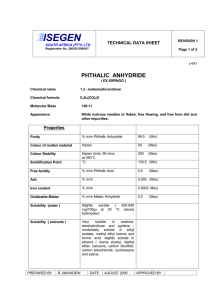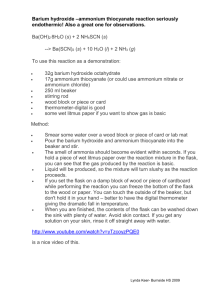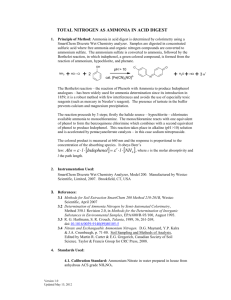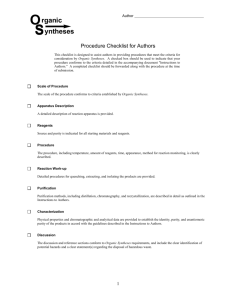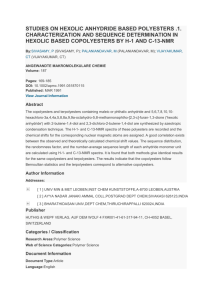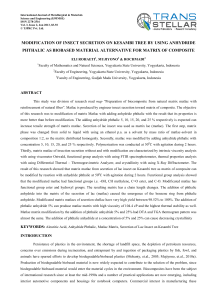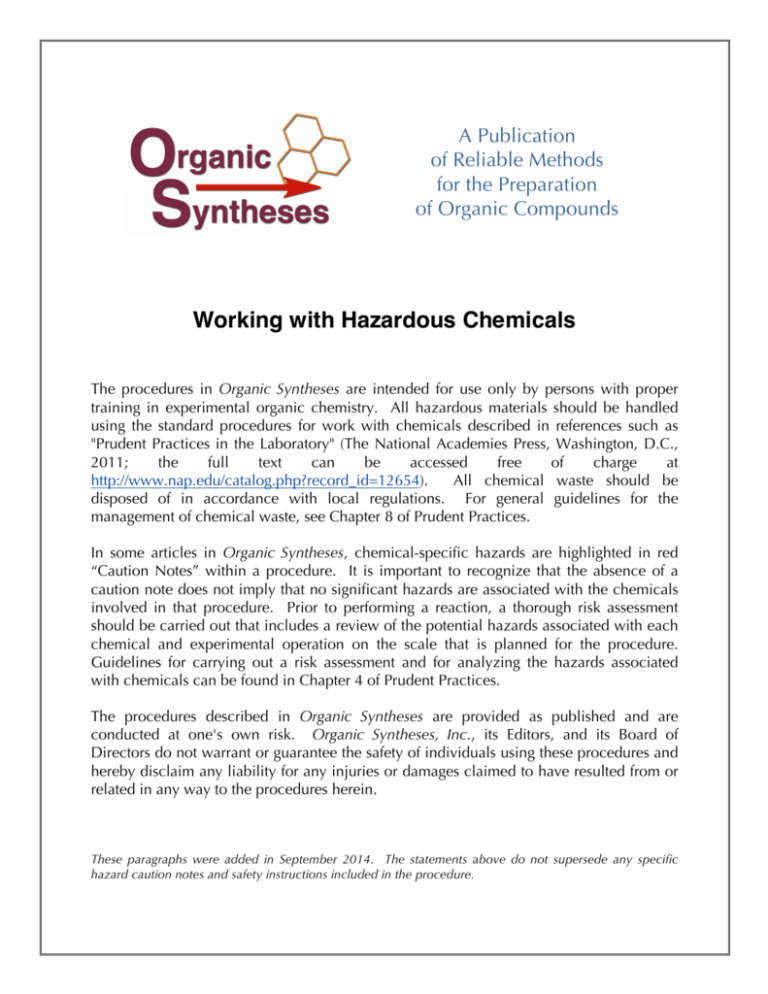
A Publication
of Reliable Methods
for the Preparation
of Organic Compounds
Working with Hazardous Chemicals
The procedures in Organic Syntheses are intended for use only by persons with proper
training in experimental organic chemistry. All hazardous materials should be handled
using the standard procedures for work with chemicals described in references such as
"Prudent Practices in the Laboratory" (The National Academies Press, Washington, D.C.,
2011;
the
full
text
can
be
accessed
free
of
charge
at
http://www.nap.edu/catalog.php?record_id=12654).
All chemical waste should be
disposed of in accordance with local regulations. For general guidelines for the
management of chemical waste, see Chapter 8 of Prudent Practices.
In some articles in Organic Syntheses, chemical-specific hazards are highlighted in red
“Caution Notes” within a procedure. It is important to recognize that the absence of a
caution note does not imply that no significant hazards are associated with the chemicals
involved in that procedure. Prior to performing a reaction, a thorough risk assessment
should be carried out that includes a review of the potential hazards associated with each
chemical and experimental operation on the scale that is planned for the procedure.
Guidelines for carrying out a risk assessment and for analyzing the hazards associated
with chemicals can be found in Chapter 4 of Prudent Practices.
The procedures described in Organic Syntheses are provided as published and are
conducted at one's own risk. Organic Syntheses, Inc., its Editors, and its Board of
Directors do not warrant or guarantee the safety of individuals using these procedures and
hereby disclaim any liability for any injuries or damages claimed to have resulted from or
related in any way to the procedures herein.
These paragraphs were added in September 2014. The statements above do not supersede any specific
hazard caution notes and safety instructions included in the procedure.
DOI:10.15227/orgsyn.002.0075
Organic Syntheses, Coll. Vol. 1, p.457 (1941); Vol. 2, p.75 (1922).
PHTHALIMIDE
Submitted by W. A. Noyes and P. K. Porter.
Checked by H. T. Clarke and J. H. Bishop.
1. Procedure
(A) In Pyrex 5-l. round-bottomed flask is placed a mixture of 500 g. (3.4 moles) of phthalic
anhydride and 400 g. (444 cc., 6.6. moles) of 28 per cent aqueous ammonia. The flask is fitted with an
air condenser not less than 10 mm. in diameter and is then slowly heated with a free flame until the
mixture is in a state of quiet fusion at a temperature of about 300° (Note 1). It requires about one hour
before all the water has gone and about one and one-half to two hours before the temperature of the
reaction mixture reaches 300° and the mixture is a homogeneous melt. It is advisable, during the
heating, to shake the flask occasionally; some material sublimes into the condenser and must be pushed
down with a glass rod. The hot reaction mixture is now poured out into a crock, covered with a paper to
prevent loss by sublimation, and allowed to cool (Note 2). The product is practically pure without
further treatment, and melts at 232–235° (Note 3). The yield is 470–480 g. (95–97 per cent of the
theoretical amount) (Note 4).
(B) Phthalimide may also be made by fusing 500 g. (3.4 moles) of phthalic anhydride and 500 g.
(4.4 moles) of ammonium carbonate which has been previously ground in a mortar. The subsequent
procedure is the same as when aqueous ammonia is used. Frequent shaking is necessary, and the
sublimed material must be pushed back occasionally into the reaction flask. About two hours are
required for completion.
2. Notes
1. On a large scale, it would be advisable to collect the small amount of ammonia given off during the
reaction.
2. If desired, the product obtained by pouring the reaction mass into the crock may be treated with hot
water to soften the cake, broken up with a glass rod, transferred to a flask, and boiled with water for a
few minutes. This treatment, however, is quite unnecessary; for all preparative purposes, the crude cake,
as it is obtained, may be ground up and used directly.
3. Phthalimide may be recrystallized from water, but only about 4 g. of phthalimide will dissolve in a
liter of boiling water. It may also be crystallized from alcohol, in which solvent it dissolves to the extent
of five parts in a hundred at boiling temperature.
4. Several smaller runs of 25 g. of phthalic anhydride gave the same percentage yield.
3. Discussion
Phthalimide can be prepared by heating ammonium phthalate,1 by heating acid ammonium
phthalate,2 and by passing dry ammonia over heated phthalic anhydride.3 It was found that the last of
these methods was by no means easy to bring about: dry phthalic anhydride is apparently only
superficially affected by the dry ammonia, and it was difficult to introduce sufficient heat into the loose
mass of crystals to initiate reaction.
This preparation is referenced from:
z
z
Org. Syn. Coll. Vol. 1, 119
Org. Syn. Coll. Vol. 2, 526
References and Notes
1. Laurent, Ann. 19, 47 (1836); Ann. 41, 110 (1842); Marignac, Ann. 42, 220 (1842); Wagner,
Jahresber. 549 (1868); Cohn, Ann. 205, 300 (1880); Landsberg, Ann. 215, 181 (1882).
2. Marignac, Jahresber. 590 (1847–48).
3. Kuhara, Am. Chem. J. 3, 29 (1881).
Appendix
Chemical Abstracts Nomenclature (Collective Index Number);
(Registry Number)
acid ammonium phthalate
alcohol (64-17-5)
ammonium carbonate (506-87-6)
ammonia (7664-41-7)
phthalic anhydride (85-44-9)
Phthalimide (85-41-6)
ammonium phthalate (523-24-0)
Copyright © 1921-2005, Organic Syntheses, Inc. All Rights Reserved

